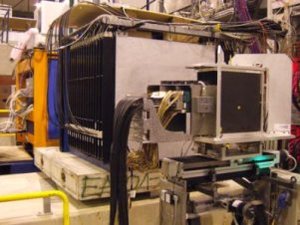Physics Prototype
From simulation to reality
In order to test the performance predicted by simulation for the shower identification and clustering separation (see left picture), and to study the realistic calorimeter cluster pattern, a large sample of hadronic clusters is needed for the wide range of hadron energies. This requires the construction of a larger prototype (middle picture). We have build a sampling calorimeter prototype of 1x1x1 m3 instrumented with plastic scintillator tiles. The light is collected in a wavelength shifting fibre and read out with a new semiconductor detector, the so called Silicon Photomultipliers (SiPM).
This physics prototype has 38 Layers containing 3x3 cm2,
6x6 cm2 and 12x12 cm2 wide, 0.5 cm thick
scintillating tiles. They are interleaved by 2 cm stainless steel.
The radiation length X0 of one passive layer of stainless steel
combined with one active layer of scintillating tiles result in 2.75 cm,
the interaction legth λi is 24.83 cm. More details are
available in a
description of the prototype implemetation in Mokka.
| Layer 1-30 # per Layer | Layer 31-38 # per Layer | Total | |
| 3 x 3 cm2 Tiles | 100 | 0 | 3000 |
| 6 x 6 cm2 Tiles | 96 | 121 | 3848 |
| 12 x 12 cm2 Tiles | 20 | 20 | 760 |
| Total # Tiles per Layer | 216 | 141 | 7608 |
| Fibres in Bundle | 19 (18+1) | 19 (18+1) | 722 (684+38) |
| # Bundles | 12 | 8 | 424 |
| LED + PIN diode | 12 | 8 | 424 |
| Total # channels | 228 | 152 | 8184 |
The physics prototype will serve as proof of principle of the chosen technologies, as well as
of a novel reconstruction method: the particle flow algorythms.
It has laready been exposed to muon, electron and hadron beam with various energies and,
although not fully equipped provided lots of useful data (see right picture).
More information about our testbeam effort.
More pictures of the prototype production and more are available.
A technical prototype that is scalable to a real ILC detector is already under construction in parallel.
back to top
Data taking:
The first 23 layers have been tested in a combined testbeam run in summer 2006 at the CERN SPS testbeam, together with the prototypes of a silicon-tungsten electromagnetic calorimeter ECAL and of a tail catcher and muon tracker TCMT.
- More than 65 million events have been collected, including electron, pion and muon data at various energies.
- Currently the analysis of these data is ongoing. The progress can be followed at the CALICE phone meetings.
- First analysis results are available as CALICE internal analysis notes.
- Further information on the testbeam setup is given at the testbeam link.
Another testbeam periode took place in summer 2007. Again at the CERN SPS beam and together with the ECAL and TCMT prototypes. This time our prototype was fully equiped (all 38 layers) and standing on a movable stage. This allowed us to take data under incoming particle angles up to 30°.
- More than 200 million events have been collected, including electron, pion and muon data at various energies and angles.
- The analysis of these data has only just started. The progress can again be followed at the CALICE phone meetings.
- Some help for analysis of testbeam data might be found in the FLC wiki and the CALICE homepage
The third data taking periode took place at Fermilab from may to september 2008.
The installation work was documented by Sven in a photogallery.
For the first time our experiment collected low energy pions, and during the second half of data taking
the silicon-tungsten ECAL was replaced by a scintillator strips - tungsten (SciW)
ECAL.
This detector combination of SciW ECAL,
our prototype described above, and the TCMT,
collected further muon, electron and low energy hadron data at FNAL in summer 2009.



